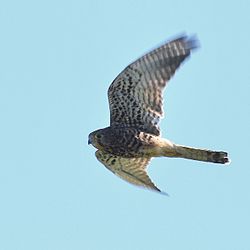Distribution and habitat
The spotted kestrel are distributed throughout Indonesia. [2]
Spread through Wallacea and Java, the spotted kestrel inhabits grasslands with scattered trees, lightly wooded cultivation, and the edges of primary and tall secondary forest. Along logging roads, it occasionally penetrates forests, and sometimes inhabits clearings within forested areas. It has also been known to live in areas of human habitation. [3]
It is likely they have small habitat ranges. They move around during the wet and dry seasons. This is information is inferred by comparing the movements of the Nankeen Kestrel (F. cenchroides), their closest relative. [2] [4] Both species are known to be more sedentary when compared to the common kestrel (F. tinnunculus). [4] [5]
Description
Spotted kestrels measure 26–32 cm (10–12.5 in) from head to tail, with a wingspan of 59–71 cm (23–28 in). On average, spotted kestrels weigh 162 g (5.7 oz). [6] The sexual dimorphism in size and plumage is less pronounced than that of the common kestrel. [2]
Males have grey tails with one broad subterminal band with white tips. Females also have grey tails with white tips, although they have 9 dark bands.
Juveniles are very similar to females, but they appear more darker and heavily marked. [2]
The eggs resemble that of the common kestrel. The colour and shape of the egg is similar to Oriental hobby (Falco severus). [7]
Behaviour
The spotted kestrel displays similar habits to that of the common kestrel. [8] Although, spotted kestrels live more sedentary lives when compared to their sister group, F. tinnunculus . [5]
Reproduction
Little is known about their breeding habits. Although, they were observed to be in a pre-breeding behaviour in June–July, during the dry season. In one instance, breeding was observed in August. Although, they also displayed breeding behaviour in December–January, during the wet season. It may be possible that they breed during both seasons, although more information is needed. [9]
Diet
The spotted kestrel feeds primarily on small mammals, birds (mostly waterfowl and doves), lizards, and insects.
The feeding behaviour of the spotted kestrel is not well known. But we can deduced the diet by looking at their closest relative, the Nankeen Kestrel (F. cenchroides). On Christmas Island, an island south of Java, Nankeen kestrels have colonized the island. The giant grasshopper ( V. irregularis ) consisted 97% of their caught prey. [10] Insects are preyed on the most, but vertebrates make up the weight of their diet. They were also seen preying on spotted dove, western bearded dragons, mice, and other birds such as the common starlings. [11] [12] [13]
Nesting
Displaying similar nesting habits to other kestrels, the spotted kestrel can be found occupying human-made structures, abandoned nests, and cliff sides. [8] In Indonesia, nests were found in a variety of locations, including the peaked roofs of traditional houses or in the crowns of palm trees. [14] Nests are usually occupied from March through September or October during mating season. [8] Similar to other falcons, the spotted kestrel does not build its own nests. Instead, it lays its eggs in abandoned nests built by other raptors or corvids. [6] They were also seen in nesting in traditional Sumbanese houses, as they provide shelter and elevation. They prefer high elevation and open habitats.
When looking at the nesting behaviour of their sister taxon (Nankeen Kestrel), clutch sizes range from 3–5 eggs. Incubation periods last up to 28 days. Males were seen assisting the females with the incubation. The fledging period last for 31 to 35 days. [15]
Voice
The spotted kestrel has a call described as common, a keek, keek, keek, similar to other kestrels. While in flight, they tend to use a more scream-like call, rrrrit, rrrrit, rrrrit. [8]
 | Songs and calls
|
This page is based on this
Wikipedia article Text is available under the
CC BY-SA 4.0 license; additional terms may apply.
Images, videos and audio are available under their respective licenses.



